It makes sense that the most popular horse breed in America also has over a dozen different registerable colors. On the registration papers, horse owners can select one of 17 color choices for American Quarter horses; however, did you know that there are more possibilities out there?
The following 17 registerable American Quarter horse colors are currently options on the American Quarter Horse Association’s (AQHA) application for registration.
Table of Contents
Black
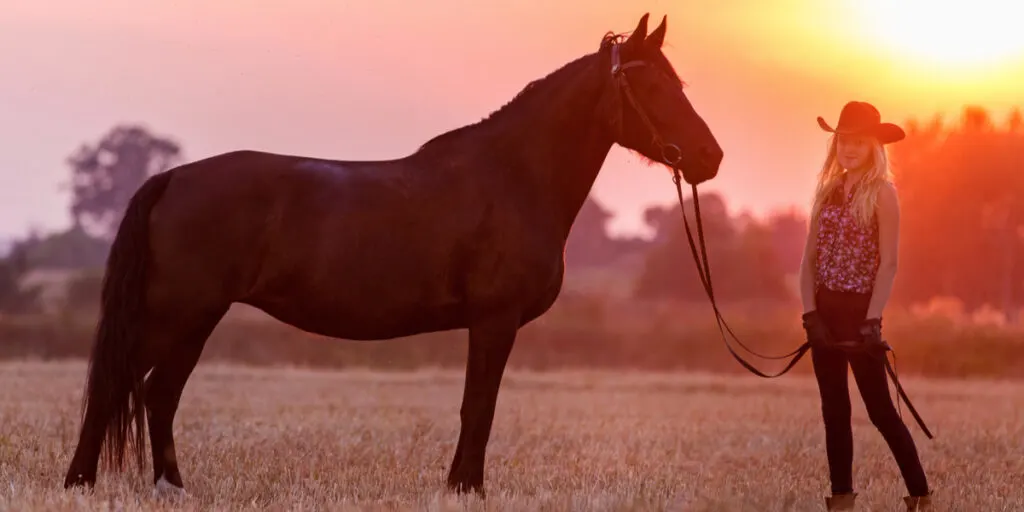
A black Quarter horse has a solid black coat along with a solid black mane and tail. The horse will not have any light spots on most of its body, apart from possible white markings on its forehead or white socks on some of its legs.
Bays and dark brown horses are sometimes mistaken for being solid black in color. However, a jet-black horse doesn’t have a red, cream, or brown tint to its coat or hair.
Brown
Brown quarter horses are either dark brown or black, with areas that are lighter than the rest of their body, particularly around their nose, mouth, and flanks. Their mane and their tail are usually black in color.
They typically do not have any white markings on the majority of their body. Occasionally, some will have white markings on their legs or head.
White
White quarter horses normally have solid white coats covering pink skin. Their eyes are usually darkly colored, while their mane is solid white.
They can have black spots on their skin, but they do not tend to have black or brown hair. Occasionally, some solid white quarter horses can have small patches of colored hair on their coat.
Gray
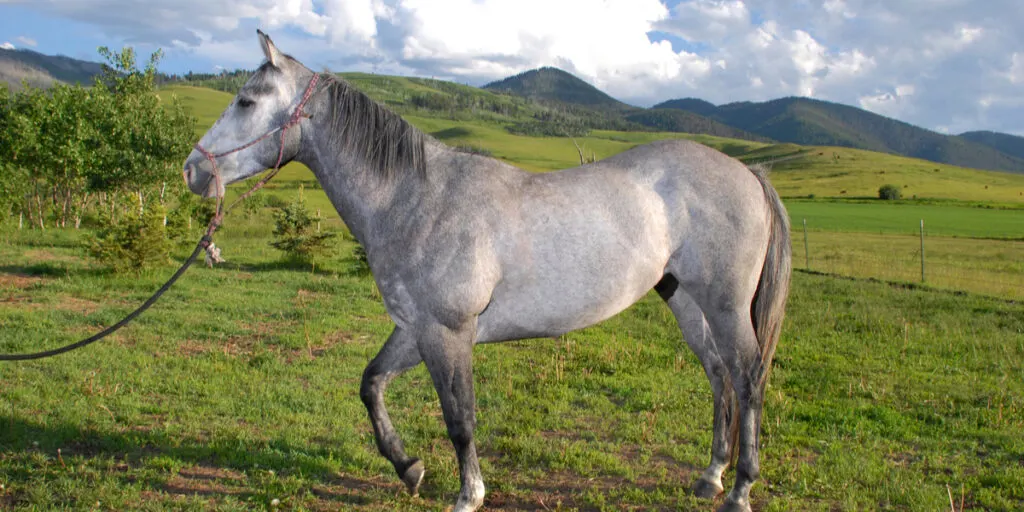
Gray quarter horses can look different depending on the stage of graying they’re in and the type of graying effect their coat has. Graying typically happens gradually, starting with the head, then progressing to the rest of their bodies.
At one stage in their aging, a gray quarter horse may appear dappled, but eventually, they will gray to the point that they look white. Graying can also lie over any base color, making the horse look like a lighter version of themselves as they age.
Sorrel
Sorrel quarter horses have coats that are reddish-brown, but they do not have any black on their bodies. Sorrels have a light copper tone to their coats, unlike chestnuts which are a darker reddish-brown color.
They can have brown or flaxen manes and tails. They do not have dorsal stripes, which are just darker stripes that run down their backs.
Sorrels do often have white markings on their faces, either a star, stripe, snip, or blaze.
Bay
Bay-colored quarter horses are either red, reddish-brown, or tan in color. They have black manes and tails as well as black on their lower legs, regardless of their shade.
They can often have white markings on different parts of their body. Bays sometimes have dorsal stripes going down their backs.
Dark brown bays can appear black, so it is important to look closely.
Chestnut
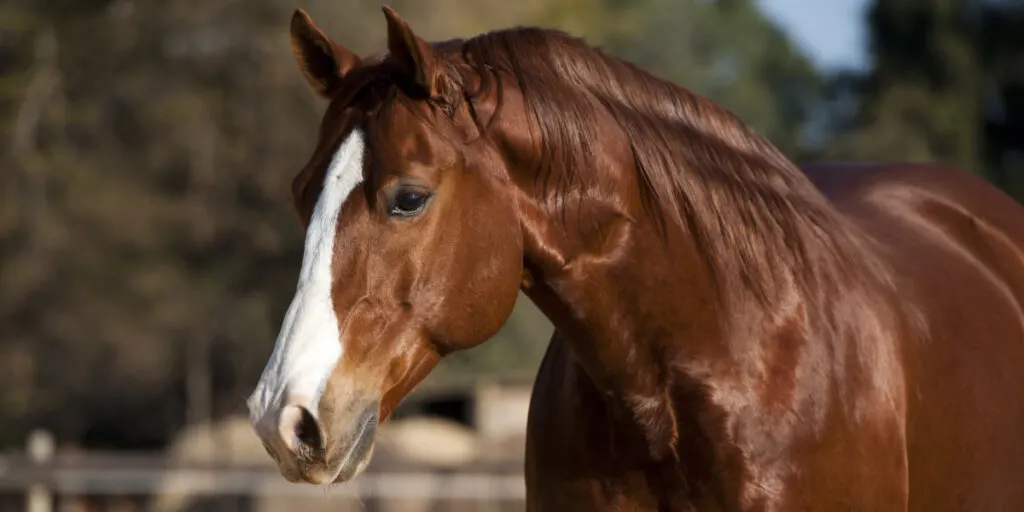
Chestnut-colored horses will have reddish-brown coats of hair that can vary in shade. These horses will not have black hairs in their coats, nor will their hair ever be black in color.
Chestnut horses will have red manes and tails; however, the shade can vary from dark to light. Their eyes will be dark and their skin will usually be black, unless when it is underneath white hair patches.
Dun
The dun color actually comes from a dilution gene acting on a horse’s base color. When equestrians describe a horse’s color as being dun in color, it means that the horse’s dun dilution gene is acting on a bay base-coat color.
Dun-colored horses will have light tan or creamy golden coats of hair, as well as have black manes and tails. The bottoms of their legs will be black as well, much like that of a bay.
Dun horses, regardless of their base color, also have a dorsal stripe down their backs. This is a stripe that is darker than the rest of their body, so it is very noticeable.
Red Dun
Red dun horses are just duns with a light reddish-tan color on their coat minus the black legs and heads that a regular dun-colored horse would have. Instead of the black bay coloration, red duns have noticeable red-tinted legs and heads.
Red duns have red manes and tails, instead of black. Instead of a bay base color, red duns have a chestnut base color on their coats which accounts for the red coloration.
Grullo
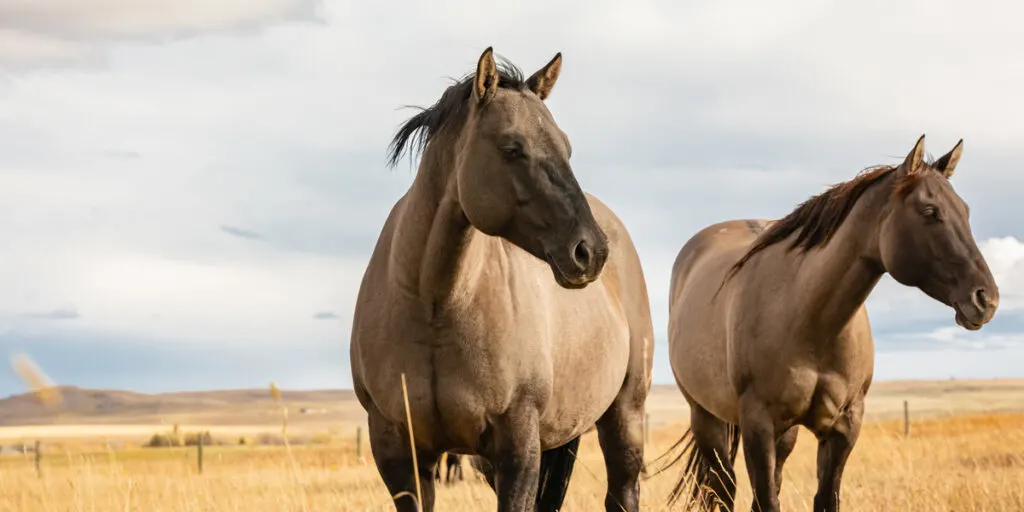
Many equestrians refer to the grullo coloration on a horse as blue dun or mouse dun. They often have dorsal stripes like duns and they have mouse-gray colored hair.
They aren’t roans since roans have combinations of white and colored hairs intermixed in their coats. Each hair of a grullo is mouse gray, just different shades. They may appear gray, however, grullo horses remain the same color throughout their lives, apart from seasonal changes when their hair can appear thicker and darker at times.
Grullo duns have a black base color, unlike the bay base color that a regular dun has.
Blue Roan
Roan-colored horses have a mix of white and colored hairs in their coats while their legs tend to be solid in color. The shade of the roan coloration depends on the horse’s base color.
Blue roans have black base colors that make their roaning (flecked pattern) appear more blue. Their legs will be black or almost black and their head will be dark as well with limited roaning.
They should also have black manes and tails. Blue roans can have white markings on the bottom of their legs or on their faces.
Red Roan
Red roans have red and white hair intermixed within their coats. Their manes and tails are red or flaxen in color.
They have chestnut-colored base coats, which means they have red-colored legs and heads. A red roan’s lighter roan coloration will appear mostly on the rest of their body.
Bay Roan
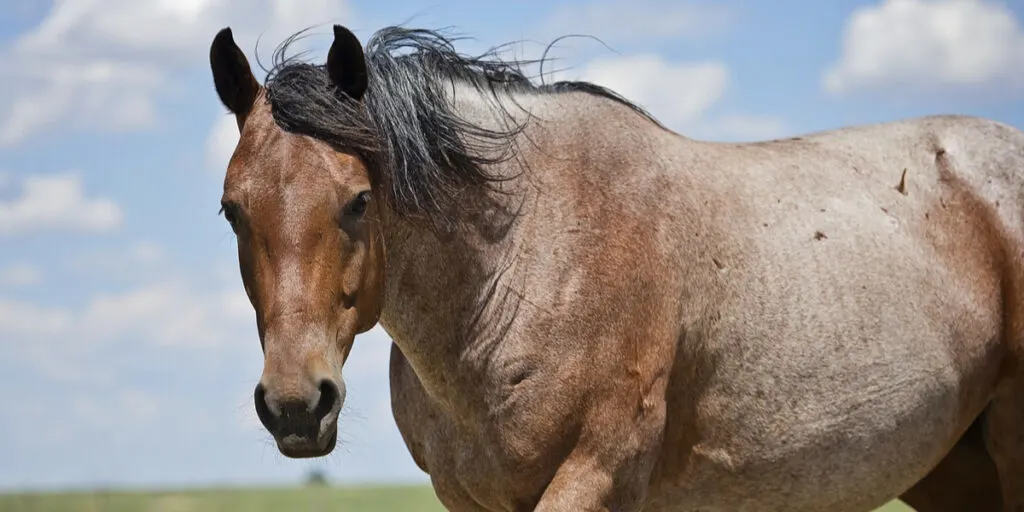
Bay roans are horses that have a roan pattern on top of their bay base color. Their coat consists mainly of red and white intermixed hairs.
Their manes and tails are black, and they have black on the lower parts of their legs like bay-colored horses have.
Buckskin
Buckskin horses have a truly unique look and appear light gold or tan in color and have black legs, manes, and tails. Their faces even have some black as well as their muzzles and ears.
The buckskin coloration happens when a bay-colored horse inherits a cream dilution gene. Buckskins are easily confused with a regular dun-colored horse; however, a buckskin will not have a dorsal stripe down its back.
Palomino
The palomino color in horses is simply breathtaking to see in person. They are gold in color and have striking white, cream, or yellow manes and tails.
Palominos also have the cream dilution gene, although in this case, their base color is chestnut, unlike buckskins who have a bay-base color. Palominos can vary in shade from almost white to a rich, extremely dark gold color.
Cremello
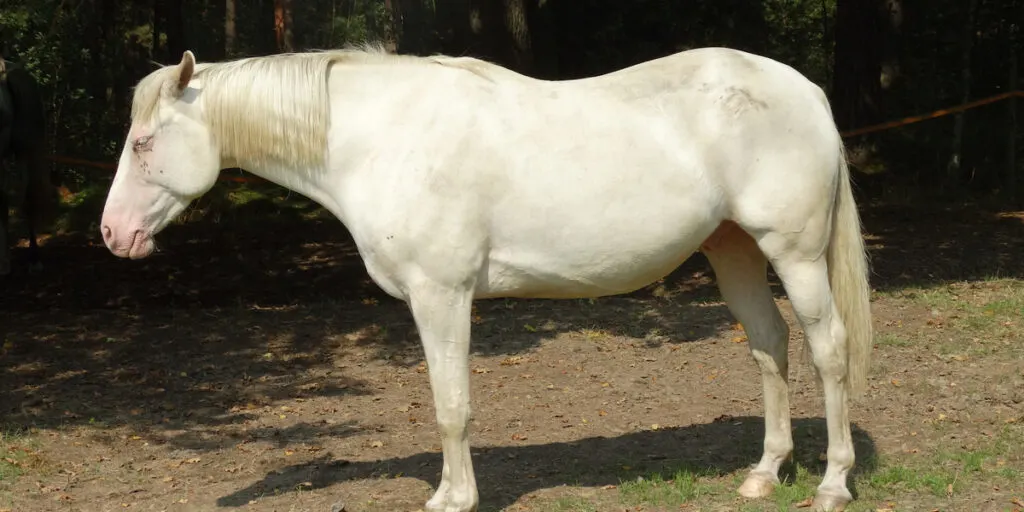
Cremello-colored horses are those with a chestnut-base color along with two separate cream dilution genes working in unison. This creates a very light cream-colored horse that has a striking white to cream-colored mane and tail.
Many people mix up very light-colored palominos with cremellos; however, cremellos have pink skin underneath their hair while palominos have black skin. This is easily seen on their noses and around their eyes.
Cremellos often have gorgeous blue eyes as well.
Perlino
Quarter horses that are perlino-colored are also cream-colored, but they are noticeably different from cremellos if you look close enough. Perlinos typically have red tones in their manes and tails that cremellos do not have.
Perlinos are horses with a bay-base color along with two cream dilution genes acting on their coat color. This accounts for why their manes and tails tend to be more red-toned or copper-toned than cremellos.
Like cremellos, perlino-colored horses also tend to have blue eyes, and they always have pink-colored skin underneath their coats.
6 Other Possible and Registerable Quarter Horse Colors
There are six additional colors that quarter horse owners can select for their specific horse; however, there is a lot more scrutiny involved. These choices are not readily available on the registration application for the AQHA, but they have made concessions so that experts can review the horse’s color to decide whether it is accurate or not.
If the experts give their stamp of approval, the owner can register the horse under one of the following six color possibilities.
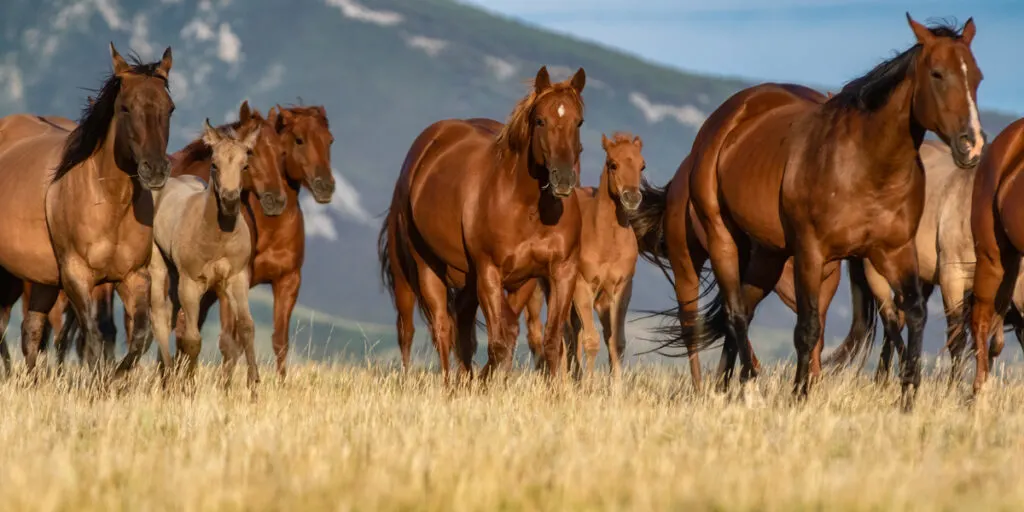
Classic Champagne
Classic champagne-colored horses have a deep, chocolate-like champagne color. This color occurs when a champagne gene acts on a black-base colored horse.
Their manes and tails are a darker chocolate color than their bodies and their eyes are usually hazel. They have pink skin, and their legs progressively get darker down to the hooves.
Quarter horses with the classic champagne color can be easily confused with grullo duns because they look so similar from a distance. However, grullo horses have mouse-gray colored coat hairs, while classic champagnes have chocolate-gold colored hairs.
Amber Champagne
Horses that have an amber champagne color are simply bay-colored horses that have a dominant champagne gene. These horses have a richer champagne coat color that is best described as being amber gold.
Their legs do appear darker than the rest of their bodies, but only a few shades darker. Their manes and tails appear dark brown, yet they tend to have blonde highlights.
Many people mistake them for buckskins; however, buckskins tend to have completely black-colored manes and tails as well as dark black points on their legs.
Gold Champagne
Quarter horses that have a gold champagne color look shockingly similar to palominos, apart from some mottling on their noses. They have gorgeous light gold to apricot-gold coats of hair along with almost white manes and tails.
The gold champagne color occurs when a horse has a chestnut bay color along with a dominant champagne gene. This dilution gene lightens the horse’s chestnut coat to light or dark gold.
All of the champagne-colored horses mentioned here tend to have a champagne sheen to their coats, hence their coat color name.
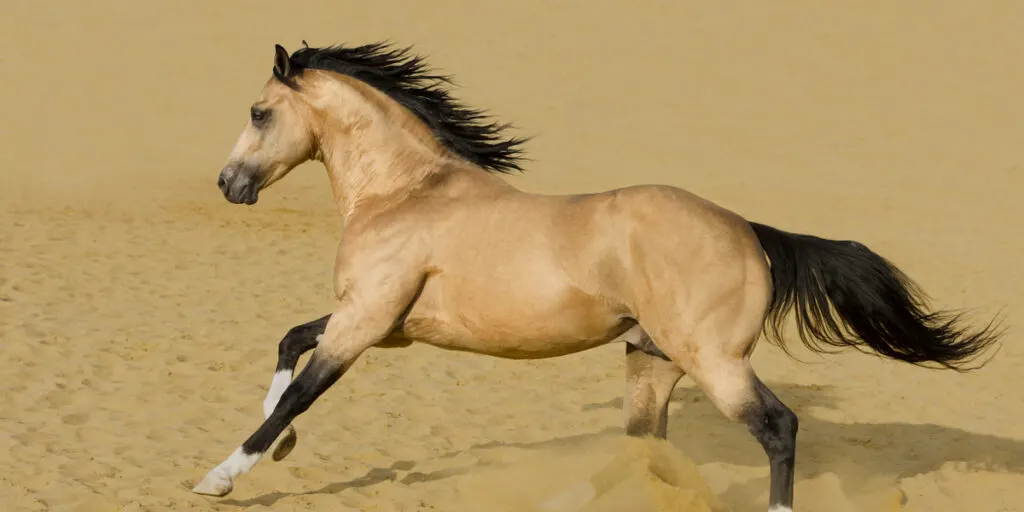
Smoky Black
Horses that are smoky black in color will look like they are black, but you will often notice some slight variations in their coat color. This is especially true as they age or if they spend a significant amount of time outdoors.
They can almost appear to have some chocolate coloring in their coats. The smoky black color is the result of a horse having only one cream dilution gene and a black base color.
Some of these horses can appear more chocolate in color, while others look like they are just solid black.
Smoky Cream
Smoky cream horses are horses with black base coats and two cream dilution genes. This causes their black base coat color to lighten to a light cream color that is almost white before they are born.
Horses that are smoky cream in color have light, almost white manes and tails. They have pink skin and striking blue eyes.
Brown Roan
Brown roan horses look a lot like blue roans; however, they are not the same. Brown roans have white and brown intermixed hairs throughout their coats, except for on the bottom of their legs and most of their heads.
A brown roan is actually a horse with an agouti color gene and the roan gene. The agouti color gene acts on their black base coat to make them appear more brown in color.
Final Thoughts
It is surprising to learn how many different registerable colors there are for the American Quarter horse. I also cannot imagine how many times I may have mistaken the color of a Quarter horse just because so many of them appear so similar at first glance. Now we know the truth; there are at least 23 recognized Quarter horse colors today. Maybe there will be even more one day.
Resources:
I had no idea there were so many registerable color options for American Quarter horses. I utilized the following sources to help write this article.
- https://en.wikipedia.org/wiki/Sorrel_(horse)#
- https://f.hubspotusercontent20.net/hubfs/5002023/Ebooks/colormarkingschart.pdf?__hstc=106933468.2dd353bae372f6579fbaffd068167f2f.1647224021904.1647224021904.1647742592355.2&__hssc=106933468.1.1647742592355&__hsfp=2192438183
- https://www.aqha.com/news-and-publications/e-books/free-ebooks/quarter-horse-markings-and-color-genetics
- https://en.wikipedia.org/wiki/Bay_(horse)
- https://en.wikipedia.org/wiki/Grullo
- https://en.wikipedia.org/wiki/Roan_(horse)
- https://en.wikipedia.org/wiki/Chestnut_(horse_color)
- https://www.aqha.com/-/horse-breeding-basics-quarter-horse-color
- https://en.wikipedia.org/wiki/Dun_gene
- https://en.wikipedia.org/wiki/Buckskin_(horse)
- https://en.wikipedia.org/wiki/Palomino
- https://en.wikipedia.org/wiki/Cream_gene
- https://en.wikipedia.org/wiki/Champagne_gene
- https://en.wikipedia.org/wiki/Smoky_black
- https://colormorgans.tripod.com/smokyblack.htm
- https://westwoodfarms.net/genetics/cream.html

